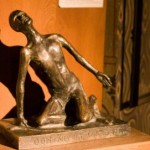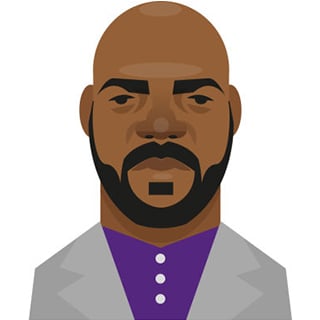 Of late (the last twenty years, say) evildoers have adopted the balaclava – a knitted head covering that hides the human face of robber, assassin, spy and terrorist, presenting a uniform mask of evil, the iconic black bad-guy to whom we are all accustomed. You name it – from the thug in the corner store hold-up to political insurgents in the Caucasus threatening the Olympic games, the black balaclava is part of the dress code. As soon as we see it, we know the enemy is here.
Of late (the last twenty years, say) evildoers have adopted the balaclava – a knitted head covering that hides the human face of robber, assassin, spy and terrorist, presenting a uniform mask of evil, the iconic black bad-guy to whom we are all accustomed. You name it – from the thug in the corner store hold-up to political insurgents in the Caucasus threatening the Olympic games, the black balaclava is part of the dress code. As soon as we see it, we know the enemy is here.
You might think, well, an honest person doesn’t wear a mask. But – balaclavas, named for a town in the Ukraine near Sevastopol, a site of fighting in the 19th c. Crimean war, were actually knitted by British women, who sent them to their own men for protection in the bitter Russian winter. The balaclava changed roles as the veterans did, returning heroes who resorted to theft in order to survive at home, after the war.
 And in fact, the enemy has always worn a mask of one kind or another. The blue-painted faces of the Celtic warriors terrified Roman soldiers, according to Caesar, in his Gallic Wars. The armored visages of Crusaders, the spike-helmeted German soldiers of WWI, the straw-hatted Vietcong, are a few of the masks of terror.
And in fact, the enemy has always worn a mask of one kind or another. The blue-painted faces of the Celtic warriors terrified Roman soldiers, according to Caesar, in his Gallic Wars. The armored visages of Crusaders, the spike-helmeted German soldiers of WWI, the straw-hatted Vietcong, are a few of the masks of terror.
An industry of images, drawn to make the enemy look inhuman and to incite our hate, is part of every war: cartoons of Germans, Japanese, Russians, turn the faces of humans into the faces of dumb or malevolent beasts. War, always the contending alternative to diplomacy (in which honor is given to the humanity of the enemy), reinforces our idea of national identity as Us v. Them, and of races, cultures, and nations as dangerous. 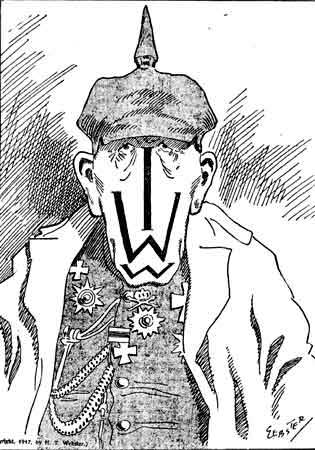
Getting even, the old law of an eye for an eye, is a part of the American value system. From politics to the military, getting even is seen as fair, even as just. Flag-waving, and enemy-decrying are fused with Christian identity in many churches and denominations, and enemy-loving is practiced in very few.
Jesus could not be more clear, that there is no righteousness in cheering for your own team, in loving those who are like you and love you; that our righteousness consists in loving the enemy, for whom God devotedly offers the same blessings we ourselves receive, sun and rain, days in which we experience sorrow and joy, hope and love. Sticking to your own kind was not a value Jesus embraced.
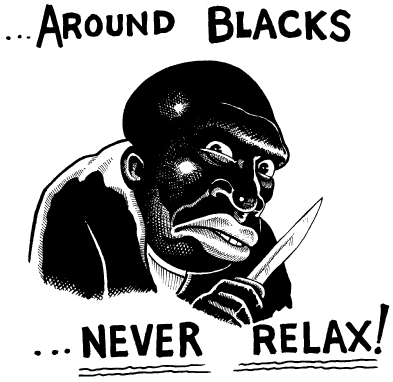 The longest running of the human distortions in America belongs to blacks, with Latinos running a close second. No masks are needed, for those with visually different skin, hair, eyes. And no cartoons are needed either, as many white Americans have internalized the cartooning of race, and see iconic distortions as part of basic recognition of difference. The heart-breaking film, Fruitvale Station, chronicles a recent tragic incident of exactly this, in California.
The longest running of the human distortions in America belongs to blacks, with Latinos running a close second. No masks are needed, for those with visually different skin, hair, eyes. And no cartoons are needed either, as many white Americans have internalized the cartooning of race, and see iconic distortions as part of basic recognition of difference. The heart-breaking film, Fruitvale Station, chronicles a recent tragic incident of exactly this, in California.
This can change.
Academic theses have been written on the transformation of public perception of the Irish, and then the Jewish, who were at first seen as non-white, and less than fully human – scholars say as black, because in America black people were defined as 3/5 human in the Constitution. But in time these groups came to be seen as white, that is, as fully human, in America – as part of us. What triggers the change is hard to identify, and what will trigger it for Latinos, for Arab Americans, and most of all, for black Americans, boggles my mind. The Holocaust caused many Americans to re-think prejudices about Jews, but the Civil War, Emancipation, segregation and civil rights have not yet fully transformed white perception of black Americans, not yet allowed neighborhoods, schools, families, and the pews of churches to integrate.
 Cheerios ran a Superbowl commercial last year featuring a white mother, a black father and a bi-racial child, and another featuring a black father and a white mother. The torrent of responses objecting to the mixed-race marriage, took the company by surprise. Some data tracking convinced them to drop the black father/white mother, and run a similar white father/black mother ad this year. That data included the rapid increase in mixed race marriages, up 26% in the past decade. But
Cheerios ran a Superbowl commercial last year featuring a white mother, a black father and a bi-racial child, and another featuring a black father and a white mother. The torrent of responses objecting to the mixed-race marriage, took the company by surprise. Some data tracking convinced them to drop the black father/white mother, and run a similar white father/black mother ad this year. That data included the rapid increase in mixed race marriages, up 26% in the past decade. But
the ad was pulled soon after it began to air.
It is in loving our enemy that the enemy is unmasked. Interracial and interfaith marriages are living proof of this. And so are the many stories veterans tell of face-to-face encounters on a battlefield with an enemy who suddenly appears to them as young, frightened, longing for home, confused, and – a brother, someone for whom they have compassion, and in that moment, decide not to kill. It is in these moments, the Jesus moments of every war, when the other shoe falls, revealing the true nature of enmity, the ugly thing we are all doing in war.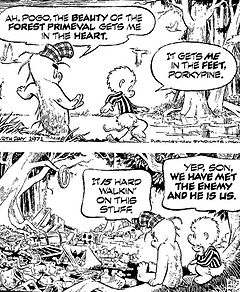
Cartoonist Walt Kelly, whose woodland philosopher Pogo Possum and his friends opined on many American situations, said in 1953, Traces of nobility, gentleness and courage persist in all people, do what we will to stamp out the trend. So, too, do those characteristics which are ugly.” Jesus, according to Matthew 5, would have agreed. And Jesus would likely say Amen to Kelly’s 1970 cartoon line, We have met the enemy and he is us.
_______________________________________
Illustrations:
1. Balaclava, enwikipedia.org/wiki/balaclava.
2. Mel Gibson in warpaint, freeze frame, Braveheart.
3. Cartoon, New York Globe, 1917, linking anti-war Wobblies to Kaiser Wilhelm. Library of Congress image.
4. Racist Cartoon. Image from Know Your Meme: Around Blacks Never Relax Gallery..
5. 2014 Superbowl Cheerios ad, freezeframe. Google Images.
6. Pogo, by Walt Kelly. Earth Day 1971 poster ‘toon, from Wikipedia, Pogo page.




